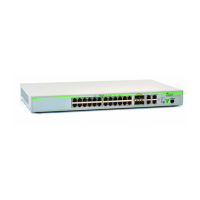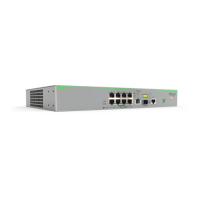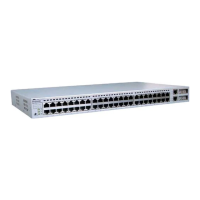Chapter 73: RMON
1208
The owner parameter is useful in situations where more than one person
is managing the switch. You can use it to identify who created the event.
This parameter is optional in all three commands.
Creating RMON
Alarms
After you have added a statistics group to a port and created the event,
you are ready to create the alarm with the RMON ALARM command,
located in the Global Configuration mode. Here is the format of the
command:
rmon alarm
alarm_id oid.stats_id
interval
interval
delta|absolute rising-threshold
rising-threshold
event
rising_event_id
falling-threshold
falling-threshold
event
falling_event_id
[owner
owner
]
The ALARM_ID parameter is a value from 1 to 65535 that uniquely
identifies the alarm. (Remember, the switch is limited to eight alarms at
one time.)
The OID.STATS_ID parameter has two parts. The first part specifies the
OID of the RMON statistic the alarm is to monitor. You have to specify the
statistic by its OID. For example, the OID for etherStatsOctets is
1.3.6.1.2.1.16.1.1.1.4.
Table 114 is a partial list of the MIB object names and numbers for use in
the OID portion of the variable. For the complete list, refer to Table 116 on
page 1222.
The second part of the OID.STATS_ID variable is the ID number of the
statistics group on the port the alarm is to monitor. The port is specified
indirectly in the command, by the ID number of the statistics group. For
example, if the alarm is to monitor port 4, use the STATS_ID variable to
enter the ID number of the statistics group on port 4. If you follow the
advice given earlier in this chapter, of always numbering statistics groups
the same as the port numbers, the port numbers and the ID numbers of
the statistics group should always be the same, thus lessening the chance
of an alarm being assigned to the wrong port.
The INTERVAL parameter specifies how frequently the switch is to poll
the statistics group to determine whether a threshold has been crossed.
Table 114. Abbreviated List of MIB Object Names and OID Numbers
MIB Name OID Number
etherStatsDropEvents 1.3.6.1.2.1.16.1.1.1.3.stats_id
etherStatsOctets 1.3.6.1.2.1.16.1.1.1.4.stats_id
etherStatsPkts 1.3.6.1.2.1.16.1.1.1.5.stats_id
etherStatsBroadcastPkts.stats_id 1.3.6.1.2.1.16.1.1.1.6.stats_id
etherStatsMulticastPkts.stats_id 1.3.6.1.2.1.16.1.1.1.7.stats_id

